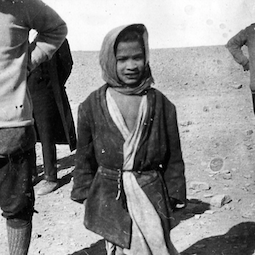Tell Hudhr (Mound I)
Tell Hudhr, labelled "Mound I" by archaeologists, lies half-way between Tell Uhaimir and Tell Ingharra in the middle of the archaeological site of Kish.
 [/kish/images/tellhudhr-fig2-large.jpg]
[/kish/images/tellhudhr-fig2-large.jpg]1. "A basket boy with one of the staff", undated. Source: OFME Photo Album, ANT 140, p. 98 (no negative number). We do not know where on Kish this photograph was taken.
The mound was used by the French Assyriologist Henri de Genouillac and his team as a camp after their arrival at Kish in January 1912. As such, this mound also became known as the "Tell of the Camp" ("Tell du campement" in French). During their stay, de Genouillac's team also dug a few pits to explore the ground. They found a few objects, among which two glass bottles from the Parthian period, and a brick dated to the reign of king Hammurabi, c.1792-1750 BCE (Gibson 1972: 69; 75). The OFME discovered more bricks from Hammurabi's time when they too opened trenches there in 1927, and again in 1929-1930. These bricks had been re-used by occupants of the city during the Islamic period (Gibson 1972: 75). Many of the sherds discovered on the surface dated from the Seleucid period (323-64 BC) up to the Late Abbasid period (936-1258 AD). A small Abbasid settlement was also found north of this mound.
15 Aug 2025
Nadia Aït Saïd-Ghanem
Nadia Aït Saïd-Ghanem, 'Tell Hudhr (Mound I)', The Forgotten City of Kish • مدينة كيش المنسية, The Kish Project, 2025 [http://oracc.org/MoundsofKish/TellHudhr/]